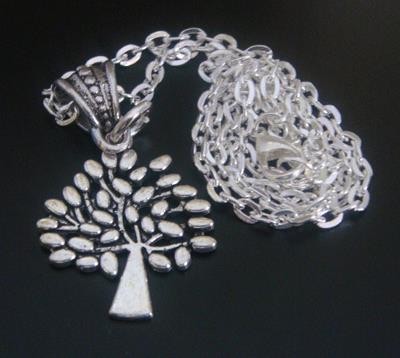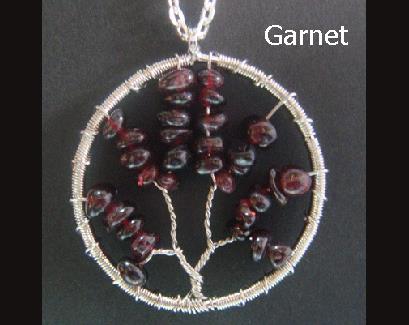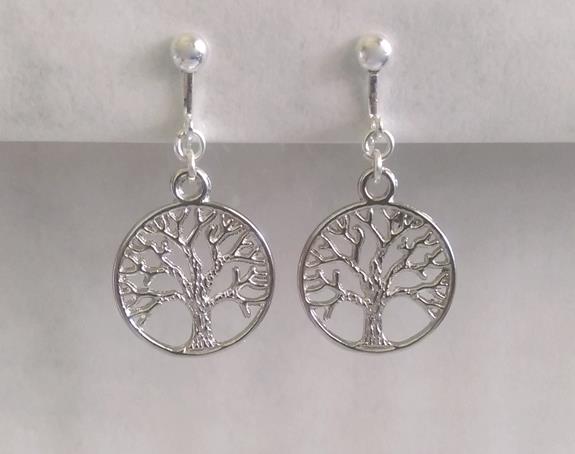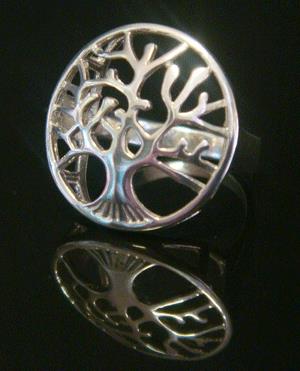Categories
- Tree of Life Necklace62
- Chiming Tree of Life Necklace4
- Tree of Life Bracelet19
- Tree of Life Earrings15
- Tree of Life Rings6
- Silver Chains & Necklace Cords2
- Tree of Life Pendant52
- Wooden Tree Of Life Necklaces4
- Gemstone Pendants22
- Tree of Life Key Rings
- More JEWELRY6
- New Products ...
- Featured Products ...
- All Products ...
New Products [more]

Tree of Life Necklace, Contemporary Design Tree, Antique Bail
Sale: $10.47
Save: 30% off

Tree Of Life Necklace Large Pendant with Garnet Gemstones
Sale: $17.47
Save: 30% off

Tree of Life Clip On Earrings with Tibetan Silver Celtic Tree
Sale: $8.75
Save: 30% off
Featured [more]

Stunning Sterling Silver Tree of Life Ring | Size 10
Sale: $31.47
Save: 30% off

Tree of Life Pendant, Celtic Woven Design, Sterling Silver
Sale: $26.57
Save: 30% off
Tree of Life - Biblical
Tree of Life Meaning - Biblical

The tree of life (Heb. ?? ????? Etz haChayim) in the Book of Genesis is a tree planted by the Abrahamic God in midst of the Garden of Eden (Paradise), whose fruit gives everlasting life, i.e. immortality. Together with the tree of life, God planted the tree of the knowledge of good and evil (Genesis 2:9). According to some scholars, however, these are in fact two names for the same tree.[1]
In the biblical story, the serpent, who is regarded as Satan in Christianity but not in Judaism, tempted Eve into eating a fruit from the tree of the knowledge of good and evil. Eve and Adam both ate the fruit, despite God's warning to Adam that "in the day that you eat from it you shall surely die" (Genesis 2:17). As a consequence of their transgression, the land, the Serpent, Adam, and Eve were each cursed by God. To prevent them access to the tree of life, God cast Adam and Eve out of the Garden of Eden:
And the Lord God said, "The man has now become like one of us, knowing good and evil. He must not be allowed to reach out his hand and take also from the tree of life and eat, and live forever." (Genesis 3:22)[2]
In the Book of Revelation, a Koine Greek phrase xylon (t?s) z?ës, ξ?λον (τ?ς) ζω?ς, is mentioned three times. This phrase, which is also used for the Genesis tree of life in the Ancient Greek translation of the Old Testament, literally means "wood of (the) life". It is translated in nearly every English Bible version as "tree of life", see Revelation 2:7, 22:2, and 22:19.
The tree of life is represented in several examples of sacred geometry and is central in particular to the Kabbalah (the mystic study of the Torah), where it is represented as a diagram of ten points.
Analysis
Serpents, trees and fruit are important symbols in the religion of Jews, Christians, and Muslims. These symbols are also found in the Norse saga of the ash tree Yggdrasil, where the tree provides a magical springwater of knowledge. In opposition to the serpent (immortality) are the eagle and hawk. There is a similar mythology in China, where a carving of a tree of life depicts a bird and a dragon (in Chinese mythology, the dragon often represents immortality). James Frazer, in his book The Golden Bough (1890), attempts to give a coherent unified account of a number of religious myths and symbols, whilst Ioan P. Couliano provides an analysis of the symbolism in The Tree of Gnosis (1991). There is a multiplicity of interpretations existing concerning the Kabbalah's tree of life (Sephiroth).
It should be noted that the tree of life and the tree of knowledge are not the same (Genesis 2.9), and that prohibition of eating the fruit only concerns the latter (Gen. 2.17). That Adam or Eve could eat of the tree of life only becomes a concern to God after they have consumed fruit from the tree of knowledge (Gen. 3.22). Although with some variation, orthodox Judaism and Christianity have interpreted the Genesis 3 account, in its most basic form, as follows:
- Genesis 2 ends with the creation of Adam and Eve and their blissful state of innocence (they are one flesh, v. 24; and not ashamed of their nakedness, v. 25).
- Gen. 3.1 introduces the "crafty" serpent who speaks to Eve and creates doubt by questioning God's interdiction from eating the fruit of the tree of the knowledge of good and evil. The serpent states that its fruit would impart divine wisdom rather than death, specifically, that she would be like God (Gen. 3.5).
- Adam and Eve are both deceived and after eating the fruit their eyes are opened and their first reaction is shame (they proceed to cover their nakedness, v. 7), then fear (they flee God's presence, v. 8).
- God converses with Adam and curses him (very hard labour), Eve (pain of childbirth) and the serpent (removing its legs) for their transgressions (Gen. 3.9-21). Only in Gen. 3.22 does God express concern about the tree of life and banishes Adam and Eve from Eden.
Many midrashim and other rabbinic commentaries have attempted to explicate and clarify the rather enigmatic creation account. Gnostic thought marks an important departure from this interpretation and often is its complete inversion. It views the serpent in a positive light, attributing to him benevolence toward humanity and portraying the God of creation (Elohim, later referred to as YHWH-Elohim) as evil, deceitful and selfish. YHWH in particular is portrayed as evil and considered a demiurge. In the Modern Era, Gnostic interpretations have made headway largely due to an increased interest in mysticism, esotericism and the gradual rejection of orthodox authority. John Milton offers the most ambiguous Eve, as she embodies both the rebel flair of Satan, whom the historical Milton is identifiable with, and also the loyalty owed to God. For Byron, she was a hero.
The tree of life and tree of knowledge have both been interpreted as forms of world tree motif which recurs in several religions and mythologies.[3]
Eastern Christianity
The Eastern Orthodox Church has traditionally understood the tree of life in Genesis as a prefiguration of the Cross, which humanity could not partake of until after the incarnation, death and resurrection of Jesus.[4]
One of the hymns chanted during the forefeast of the nativity of Christ says:
Make ready, O Bethlehem, for Eden hath been opened for all. Prepare, O Ephratha, for the tree of life hath blossomed forth in the cave from the Virgin; for her womb did appear as a spiritual paradise in which is planted the divine Plant, whereof eating we shall live and not die as did Adam. Christ shall be born, raising the image that fell of old.[5]
The cross of Christ is also referred to as the tree of life, and in the service books, Jesus is sometimes likened to a "divine cluster" of grapes hanging on the "Tree of the Cross" from which all partake in Holy Communion.
This theme is also found in Western Christianity. By way of an archetypal example consider Bonaventure's "biography" of the second person of the Trinity, entitled "The Tree of Life." [see Cousins, The Classics of Western Spirituality Series]
Western Christianity
Until the Enlightenment, the Christian church generally gave biblical narratives of early Genesis the weight of historical narratives. In the City of God (xiii.20-21), Augustine of Hippo offers great allowance for "spiritual" interpretations of the events in the garden, so long as such allegories do not rob the narrative of its historical reality. However, the allegorical meanings of the early and medieval church were of a different kind than those posed by Kant and the Enlightenment. Precritical theologians allegorized the genesis events in the service of pastoral devotion. Enlightenment theologians (culminating perhaps in Brunner and Niebuhr in the twentieth century) sought for figurative interpretations because they had already dismissed the historical possibility of the story.
Others sought very pragmatic understandings of the tree. In the Summa Theologica (Q97), Thomas Aquinas argued that the tree served to maintain Adam's biological processes for an extended earthly animal life. It did not provide immortality as such, for the tree, being finite, could not grant infinite life. Hence after a period of time, the man and woman would need to eat again from the tree or else be "transported to the spiritual life." The common fruit trees of the garden were given to offset the effects of "loss of moisture" (note the doctrine of the humors at work), while the tree of life was intended to offset the inefficiencies of the body. Following Augustine in the City of God (xiv.26), “man was furnished with food against hunger, with drink against thirst, and with the tree of life against the ravages of old age.”
John Calvin (Commentary on Genesis 2:8), following a different thread in Augustine (City of God, xiii.20), understood the tree in sacramental language. Given that humanity cannot exist except within a covenantal relationship with God, and all covenants use symbols to give us "the attestation of his grace", he gives the tree, "not because it could confer on man that life with which he had been previously endued, but in order that it might be a symbol and memorial of the life which he had received from God." God often uses symbols - He doesn’t transfer his power into these outward signs, but "by them He stretches out His hand to us, because, without assistance, we cannot ascend to Him." Thus he intends man, as often as he eats the fruit, to remember the source of his life, and acknowledge that he lives not by his own power, but by God’s kindness. Calvin denies (contra Aquinas and without mentioning his name) that the tree served as a biological defense against physical aging. This is the standing interpretation in modern Reformed theology as well.
Church of Jesus Christ of Latter Day Saints
According to the Book of Mormon, the prophet Lehi is shown the tree of life in a dream or vision before he leaves Jerusalem, between 600 and 592 BC. Lehi described the tree as "a tree, whose fruit was desirable to make one happy." (1 Nephi 8:10)
Lehi's son, Nephi, is also shown the vision sometime later. This is recounted in 1 Nephi 11:8-11, "And it came to pass that the Spirit said unto me: Look! And I looked and beheld a tree; and it was like unto the tree which my father had seen; and the beauty thereof was far beyond, yea, exceeding of all beauty; and the whiteness thereof did exceed the whiteness of the driven snow. And he said unto me: What desirest thou? And I said unto him: To know the interpretation thereof." Nephi is then shown in vision Mary with the baby Jesus in her arms, after which the Spirit says "Behold the Lamb of God, yea, even the Son of the Eternal Father! Knowest thou the meaning of the tree which thy father saw? And I answered him, saying: Yea, it is the love of God, which sheddeth itself abroad in the hearts of the children of men; wherefore, it is the most desirable above all things. And he spake unto me, saying: Yea, and the most joyous to the soul." (1 Nephi 11:21-23)
As stated in the above quotation, the tree of life is interpreted to represent "the love of God". The fruit is also described in 1 Nephi 15:36 as being "the greatest of all the gifts of God", and in Doctrine and Covenants 6:13 and Doctrine and Covenants 14:7, salvation and eternal life are described as being "the greatest of all the gifts of God". The vision is thus interpreted to mean that those who go through their earthly life holding fast to the gospel of Jesus Christ (represented by an iron rod leading through a mist of blackness, 1 Nephi 8:19-24) will be able to be redeemed through the grace of God and achieve salvation and eternal life. Through this they might be able to have joy and happiness, as Lehi and the Spirit explained that the fruit was "desirable to make one happy" and "joyous to the soul".
References
- ^ The Eden narrative: a literary and ... - Tryggve Mettinger - Google Books
- ^ Hebrew/Christian Creation Myth: Genesis 1-3 (New International Version)
- ^ world tree in the Encyclopædia Britannica
- ^ Roman, Dr. Alexander, Tree of Life in the Garden of Eden ([dead link] – Scholar search), Ukrainian Orthodoxy
- ^ ORTHODIXIE ... Southern, Orthodox, Convert, Etc.: Word & Virgin, Mary & Child
excerpts from Wikipedia, the free encyclopedia, Text is available under the Creative Commons Attribution-ShareAlike License





